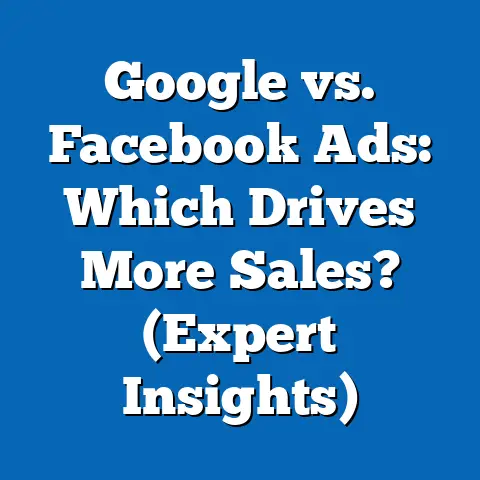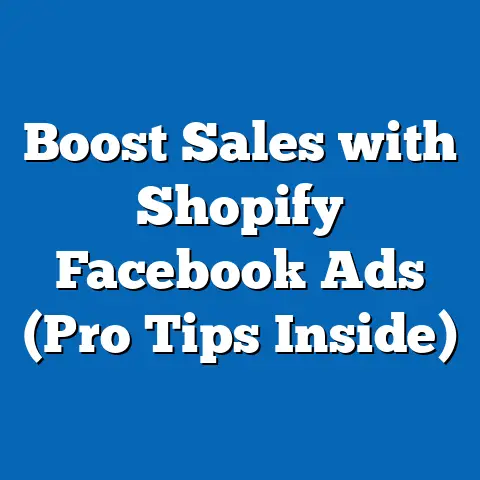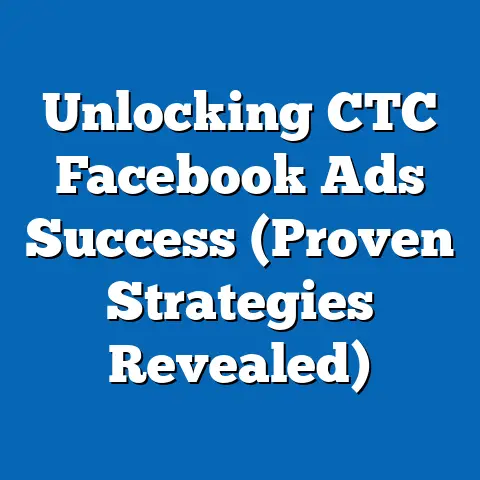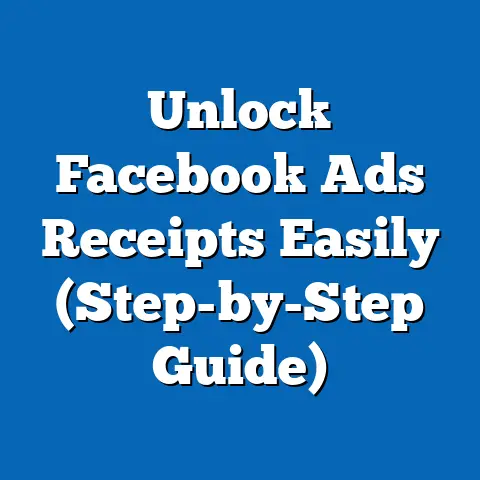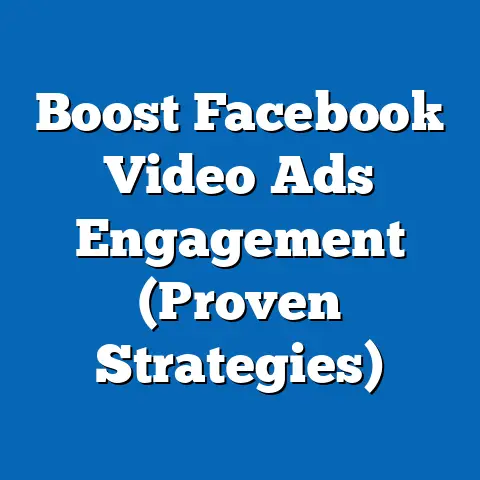Master Budget: Optimize Facebook Ads for Success (Smart Strategies)
I still remember the thrill and anxiety of launching my first Facebook ad campaign. It was late, I was hunched over my laptop at a local coffee shop, and my heart pounded as I clicked the “Publish” button. The mix of hope and fear was palpable – would this be the key to unlocking massive growth, or just a costly experiment? The truth is, without a well-defined budget and a strategic approach, it could easily have been the latter. That’s why I want to share my experience and knowledge to help you avoid the same pitfalls and truly master your Facebook advertising budget.
Understanding the Importance of a Master Budget in Facebook Advertising
A master budget in Facebook advertising is more than just a spreadsheet with numbers; it’s a comprehensive plan that outlines how your ad spend will be allocated across different aspects of your campaign. Think of it as the financial roadmap that guides your advertising efforts, ensuring that every dollar is spent intentionally and strategically.
Why is this so important? Because without a master budget, you’re essentially driving blind. You might be throwing money at ads without a clear understanding of what’s working, what’s not, and whether you’re even on track to achieve your goals.
The risks of operating without a budget are significant:
- Overspending: Without a budget, it’s easy to get carried away and spend more than you can afford, especially when you see initial positive results.
- Inefficiency: You might be wasting money on ads that aren’t performing well, or targeting the wrong audiences.
- Lack of Focus: Without a budget, it’s hard to prioritize your efforts and focus on the most important areas.
- Missed Opportunities: You might miss out on opportunities to scale successful campaigns or test new strategies.
A well-structured master budget should include allocations for the following key components:
- Creative: This includes the cost of producing high-quality images, videos, and ad copy.
- Targeting: This covers the cost of researching and defining your target audiences.
- Testing: This is the money you set aside to experiment with different ad formats, targeting options, and bidding strategies.
- Scaling: This is the budget you’ll use to expand successful campaigns and reach a wider audience.
Takeaway: A master budget is the foundation of a successful Facebook advertising strategy. It helps you allocate resources effectively, avoid overspending, and maximize your return on investment.
Setting Clear Objectives and KPIs
Before you even think about setting a budget, you need to define your objectives. What do you want to achieve with your Facebook ads? Are you trying to increase brand awareness, generate leads, drive sales, or something else entirely?
Your objectives will dictate how you allocate your budget. For example, if your goal is to increase brand awareness, you might focus on reaching a large audience with engaging content. On the other hand, if your goal is to generate leads, you might focus on targeting a specific audience with a lead magnet offer.
Key Performance Indicators (KPIs) are the metrics you’ll use to measure your progress towards your objectives. Some common KPIs for Facebook ads include:
- Cost Per Click (CPC): The amount you pay each time someone clicks on your ad.
- Click-Through Rate (CTR): The percentage of people who see your ad and click on it.
- Conversion Rate: The percentage of people who click on your ad and take a desired action, such as making a purchase or filling out a form.
- Return on Ad Spend (ROAS): The amount of revenue you generate for every dollar you spend on ads.
Let’s look at some examples of how different objectives might require different budget strategies:
-
Objective: Increase Brand Awareness
- KPIs: Reach, Impressions, Engagement
- Budget Strategy: Allocate a larger portion of your budget to reaching a broad audience with visually appealing content. Focus on optimizing for reach and frequency.
-
Objective: Generate Leads
-
KPIs: Cost Per Lead (CPL), Lead Quality
- Budget Strategy: Target a specific audience with a compelling lead magnet offer. Focus on optimizing for conversions and lead quality.
-
Objective: Drive Sales
-
KPIs: ROAS, Conversion Rate, Average Order Value
- Budget Strategy: Target customers who are likely to purchase your product or service. Use retargeting to reach people who have already shown interest. Focus on optimizing for conversions and ROAS.
Objective: Increase Brand Awareness
- KPIs: Reach, Impressions, Engagement
- Budget Strategy: Allocate a larger portion of your budget to reaching a broad audience with visually appealing content. Focus on optimizing for reach and frequency.
-
Objective: Generate Leads
-
KPIs: Cost Per Lead (CPL), Lead Quality
- Budget Strategy: Target a specific audience with a compelling lead magnet offer. Focus on optimizing for conversions and lead quality.
-
Objective: Drive Sales
-
KPIs: ROAS, Conversion Rate, Average Order Value
- Budget Strategy: Target customers who are likely to purchase your product or service. Use retargeting to reach people who have already shown interest. Focus on optimizing for conversions and ROAS.
Objective: Generate Leads
KPIs: Cost Per Lead (CPL), Lead Quality
Objective: Drive Sales
KPIs: ROAS, Conversion Rate, Average Order Value
Takeaway: Clearly defining your objectives and KPIs is essential for setting a realistic and effective Facebook advertising budget. Your objectives will dictate how you allocate your budget, and your KPIs will help you measure your progress and make adjustments as needed.
Audience Segmentation and Targeting Strategy
One of the most powerful features of Facebook advertising is its ability to target specific audiences based on their demographics, interests, and behaviors. By segmenting your audience and tailoring your ads to different groups, you can significantly improve your results and optimize your ad spend.
Here are some methods for dividing your audience into segments:
- Demographics: Age, gender, location, education, income.
- Interests: Hobbies, passions, activities.
- Behaviors: Purchase history, online activity, device usage.
- Custom Audiences: People who have interacted with your website, app, or Facebook page.
- Lookalike Audiences: People who are similar to your existing customers.
The key is to test different audiences and see which ones respond best to your ads. You can then adjust your budgets accordingly, allocating more money to the audiences that are generating the best results.
Facebook’s Audience Insights tool is an invaluable resource for informing your budgeting decisions. This tool allows you to explore the demographics, interests, and behaviors of people who are connected to your Facebook page or who are part of a custom audience. By using Audience Insights, you can gain a deeper understanding of your target audience and create more effective ad campaigns.
For example, let’s say you’re selling organic skincare products. Using Audience Insights, you might discover that your target audience is primarily women aged 25-45 who are interested in natural beauty, healthy living, and eco-friendly products. You can then use this information to create targeted ad campaigns that appeal specifically to this audience.
Takeaway: Audience segmentation and targeting are crucial for optimizing your Facebook ad spend. By understanding your target audience and tailoring your ads to their specific needs and interests, you can significantly improve your results and maximize your ROI.
The Creative Budget: Investing in Quality Content
In the world of Facebook advertising, creative is king (or queen!). No matter how well you target your audience or how carefully you optimize your bidding strategy, your ads will fall flat if your creative is boring, irrelevant, or poorly produced.
That’s why it’s so important to allocate a significant portion of your budget to creating high-quality ad creative. This includes:
- Images: High-resolution, visually appealing images that capture attention and convey your message.
- Videos: Engaging videos that tell a story and showcase your product or service.
- Copywriting: Compelling ad copy that grabs attention, highlights the benefits of your offer, and includes a clear call to action.
The amount you allocate to creative production will depend on your industry, your target audience, and your budget. However, as a general rule, I recommend allocating at least 20-30% of your total budget to creative.
If you’re on a tight budget, don’t worry – there are still ways to create effective ad creatives without breaking the bank. Here are a few strategies:
- User-Generated Content: Encourage your customers to create content featuring your product or service. This can be a great way to get authentic and engaging content at a fraction of the cost of professional production.
- Repurpose Existing Assets: Look for opportunities to repurpose existing content, such as blog posts, videos, or infographics. You can easily adapt this content for use in your Facebook ads.
- DIY Tools: Utilize free or low-cost design tools like Canva to create visually appealing graphics and videos.
A/B testing different creatives is also essential for finding the most effective combinations. Experiment with different images, videos, and ad copy to see what resonates best with your target audience. You can use Facebook’s A/B testing tool to easily test different versions of your ads and track their performance.
Takeaway: Investing in high-quality ad creative is essential for driving engagement and conversions. Allocate a significant portion of your budget to creative production and use A/B testing to find the most effective combinations.
Tracking and Analyzing Performance
Once your ads are up and running, it’s crucial to continuously monitor their performance against your master budget. This means tracking your spend, analyzing your results, and making adjustments as needed.
Facebook Ads Manager provides a wealth of data and analytics that you can use to track your spend and performance. Some key metrics to monitor include:
- Impressions: The number of times your ad has been shown.
- Reach: The number of unique people who have seen your ad.
- Clicks: The number of times people have clicked on your ad.
- CPC: The amount you’re paying for each click.
- CTR: The percentage of people who see your ad and click on it.
- Conversions: The number of people who have taken a desired action, such as making a purchase or filling out a form.
- ROAS: The amount of revenue you’re generating for every dollar you spend on ads.
The concept of optimization is central to successful Facebook advertising. This means adjusting your budgets, targeting, and creative based on performance data. If you see that a particular ad is performing well, you might increase its budget to reach a wider audience. On the other hand, if you see that an ad is not performing well, you might pause it or adjust its targeting or creative.
Here are some common performance pitfalls and how to pivot your budgets accordingly:
- Low CTR: If your CTR is low, it means that your ad is not resonating with your target audience. Try testing different images, videos, or ad copy.
- High CPC: If your CPC is high, it means that you’re paying too much for each click. Try refining your targeting or adjusting your bidding strategy.
- Low Conversion Rate: If your conversion rate is low, it means that people are clicking on your ad but not taking the desired action. Try improving your landing page or making your offer more compelling.
- Negative ROAS: If your ROAS is negative, it means that you’re losing money on your ads. Try adjusting your targeting, creative, or bidding strategy.
Takeaway: Continuous monitoring and analysis of ad performance are essential for optimizing your Facebook advertising budget. Use Facebook Ads Manager to track your spend and performance, and be prepared to make adjustments as needed.
Scaling Successful Campaigns
Once you’ve identified successful Facebook ad campaigns, it’s time to think about scaling them. Scaling means expanding your campaigns to reach a wider audience and generate even more results.
The key to successful scaling is to do it gradually and strategically. Don’t just double or triple your budget overnight. Instead, increase your budget incrementally and monitor your performance closely.
Here’s the concept of incremental budget increases and the importance of maintaining performance:
- Start Small: Increase your budget by 10-20% at a time.
- Monitor Performance: Track your KPIs closely to see how your performance is affected.
- Adjust as Needed: If you see that your performance is declining, reduce your budget or adjust your targeting or creative.
- Repeat: Continue to increase your budget incrementally and monitor your performance until you reach your desired scale.
Let’s look at a hypothetical scenario illustrating successful scaling:
You’re running a Facebook ad campaign that’s generating a ROAS of 3.0. You decide to increase your budget by 20%. After a week, you see that your ROAS has dropped to 2.5. You decide to reduce your budget back to its original level and adjust your targeting to improve your ROAS. After another week, you see that your ROAS has returned to 3.0. You then decide to try increasing your budget again, but this time by only 10%. This time, your ROAS remains stable at 3.0.
The balance between maintaining return on ad spend (ROAS) and increasing budget is crucial. You want to increase your budget as much as possible without sacrificing your ROAS.
Takeaway: Scaling successful Facebook ad campaigns is a strategic process that requires careful monitoring and analysis. Increase your budget incrementally, monitor your performance closely, and be prepared to make adjustments as needed.
Adjusting the Master Budget Over Time
Your master budget is not set in stone. As market conditions change, business goals evolve, and you learn more about what works and what doesn’t, you’ll need to adjust your budget accordingly.
Seasonal adjustments are particularly important. For example, if you’re selling holiday-themed products, you’ll want to increase your budget during the holiday season. Similarly, if you’re running a promotion, you’ll want to increase your budget to promote the offer.
External factors can also influence your budgeting decisions. For example, a new competitor entering the market might require you to increase your budget to maintain your market share. Or, a change in Facebook’s advertising policies might require you to adjust your targeting or creative.
Here are some tips for revisiting and revising your master budget based on past performance and future projections:
- Review your budget regularly: I recommend reviewing your budget at least once a month.
- Analyze your performance data: Look for trends and patterns in your performance data.
- Consider your business goals: Make sure your budget is aligned with your overall business goals.
- Be flexible: Be prepared to make adjustments to your budget as needed.
Takeaway: Your master budget should be a living document that evolves over time. Regularly review your budget, analyze your performance data, and be prepared to make adjustments as needed.
Reflecting on the Journey to Mastering Your Budget
Mastering your Facebook advertising budget is a journey, not a destination. It requires a combination of strategic planning, continuous monitoring, and a willingness to adapt to changing conditions.
Remember, success in Facebook advertising is not solely about spending money, but about strategically investing in the right areas. By setting clear objectives, understanding your target audience, investing in high-quality creative, and continuously optimizing your campaigns, you can maximize your return on investment and achieve your business goals.
I encourage you to view your budgeting process as an evolving strategy that can lead to sustained success and growth in your advertising efforts. Take the time to plan, track, and optimize your budget, and you’ll be well on your way to mastering Facebook advertising. Now, go out there and make those smart investments!


